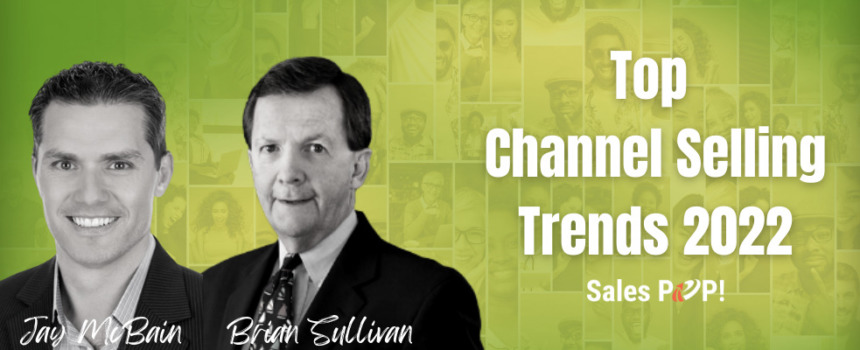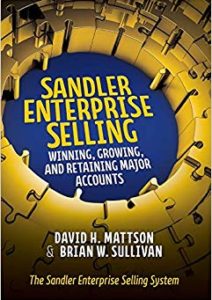To kick off 2022, Brian Sullivan interviews Jay McBain about the key trends impacting channels in the new year and beyond. Jay is one of the most visible and respected thought leaders in global channels, having been named 2021 Channel Influencer of the Year by Channel Partners Magazine. He was also included in the “Top 40 Under 40” by The Business Review and was recognized on many other channel magazines’ top influencer lists. He is often sought out for industry guidance and future trends and has spent his 27-year career in various executive channel sales, marketing, and strategy roles with IBM, Lenovo, Autotask, and ChannelEyes. Jay is the principal analyst for global channels, partnerships, and ecosystems at Forrester – one of the most influential global research and advisory firms in the world. In addition to being a SalesPOP! Top Contributor, Brian Sullivan is an enterprise selling expert, best-selling author, and Chief Sales Strategist at System Soft Technologies.
Here’s the interview:
Thanks so much for joining me today, Jay. You and I have been chatting about the future of tech spending and its impact on channels and worldwide commerce in general. Your perspective, as always, is really insightful so would you mind sharing your thoughts on the topic?
Certainly, Brian. Great question to get us started and there’s much to discuss. Worldwide telco and tech spending will double in the next decade. And that growth, from $3.5 trillion to $7 trillion, will take place among “a ton of change.”
Currently, 64% of the $3.5 trillion telco and tech spend comes through the indirect channel. But that will change. In fact, as we look toward the end of the decade, we’re starting to see some shift in the way money changes hands. 1/3 will flow from indirect, 1/3 from marketplaces and 1/3 from direct. But behind the scenes, the role of the indirect channel will become more important than ever. The channel for 40 years has been synonymous with the flow of money, but what isn’t talked about enough is that about 90% of that number is partner-assisted. For instance, Microsoft sales have always been more than 90% through the channel. But now they talk about 96% being ”partner-assisted”. They never talk about partner-sourced anymore. Similarly, Azure has grown by 50% per quarter for the last six quarters but only about 30% of that growth is through the channel. But it’s 96% “partner-assisted”.
As you say, Jay, “a ton of change”. And regarding the changing buying journey, I know you closely track the key trends that impact the channel. Do you have a perspective to share regarding the really impactful trends?
I do, Brian. To illustrate the channel’s evolving and escalating role in the changing buying journey, I created a Top 10 List of “uber-level” trends affecting the channel. While some are within the channel and some are not, when you combine these ten together, they’re going to be the most impactful things in the next decade. And the companies that take advantage of these converging and accelerating trends will be the ones growing at triple digits.
That’s terrific, Jay. Would you walk us through the highlights of your “Top Ten”?
Happy to, Brian. First, tech buying Is changing and so are psychology, behavior and the journey itself. There’s a demographic shift happening for the first time in a long time and the majority of buyers are going to be millennials within four years. Additionally, technology buying is becoming more consumer-like, with buyers doing online research, reading reviews and watching video cookies.
Then, we’re seeing the end of the cookie. Google and Apple recently announced they were eliminating the online cookies used to target and trace consumer behaviors. The companies that own 99% of mobility and 86% of desktop browsing share no longer tracking the buying journey will be huge for the industry. Indirect sellers will become vital for their influence.
Next, 76% of CEOs think their current business models will be unrecognizable. Public and private companies alike are feeling pressure to think about subscription and consumption models and recurring revenue, which those in the telco and MSP markets already know and already do. These companies cited the need to build teams to address all the facets of the ecosystem and they expect to move forward as part of a team.
Fascinating, Jay. And do you see this movement in changing models affecting a broader spectrum of firms?
Absolutely, which leads to the next trend regarding the worldwide shift to subscription and consumption models. Cisco, Dell, Lenovo, and IBM are following HPE in moving to a subscription-only model. Instead of one-time purchase fee, there’s now a monthly fee. Within this subscription economy, a subscription company is rated with the same type of metrics as an entity like Netflix, with the focus being on the number of subscribers, churn rate, etc.
Also, the embedded/white-labeled future is replacing the SKU. Despite leading the field in the number of patents received for 28 straight years, IBM saw revenue drop for 10 straight years. Interestingly, they never monetized that innovation. In an inventive world, we’re not product sales companies anymore as growth will come from driving adoption, deeper integrations, stickiness, and driving cross-sell/upsell/enrichment of other parts of portfolios and other innovations.
And marketplaces will accelerate the resell decline as by the end of the decade, there will be twenty leading marketplaces that account for 80% of the marketplace opportunities. The remaining 20% will go into niche marketplaces.
On the topic of marketplaces, you have a point of view on marketplace taxation that represents a key trend as well, correct?
Yes. Marketplace taxation is taking center stage as the topic is being very closely examined. Microsoft lowered its taxation from 20% to 3% with Google following suit 30 days later and AWS sitting at 5% “with ways to get to 3%.” Hyperscalers are now at a new level of taxation as the marketplace levels are just now getting to where they should be with the next year promising further shakedown.
The next key trend involves the tech workforce as fully 72% of U.S. tech workers are considering quitting In 2022. Now, that’s not actually going to happen, but it’s probably going to be bigger than ‘The Great Resignation’ as they’re calling it. In tech, people are definitely thinking about a different future of work.
And in channels, Jay, what about the distributors, many of whom are facing uncertain futures?
Indeed, they are as much distributor disruption will continue. There are new players among the distributors and there’s a lot of consolidation going on. There are two critical things they need to do. They need to become a platform for distribution, and they must come out of hiding.
And finally, the ecosystem orchestrator has become the new trusted advisor. With all the moving parts in the ecosystem, a real level of orchestration is needed. The company and the people that can truly take on the role of orchestrating everything are going to be upsized winners in this decade. There’s no single throat to choke anymore and no single trusted advisor. But there’s a level of orchestration that has massive opportunities for triple-digit growth every year moving forward.”
Thanks so much, Jay, for your thoughtful perspectives and we’ll all be following your work at https://www.forrester.com/blogs/author/jay_mcbain/
All the best!














































Comments